Initiating a program to continue classes even when typhoons close schools

After severe tropical storm Kristine left the country comes the recovery phase. How fast can infrastructure be repaired, or built to replace the structures that were damaged or destroyed? How fast can people go back to a gainful occupation after experiencing strong winds and rains that damaged their houses or business enterprises?
How soon can students resume their studies to prevent learning loss? Too many instances of suspended classes due to a storm or typhoon could impact the learning of students. Reports said 18,645,544 learners in 35,973 schools were affected nationwide.
After a typhoon leaves, several situations prevent face-to-face classes to resume. Among these are damaged classrooms, closed roads leading to the school, and no electricity in many areas. The use of school campuses and classrooms as evacuation centers has also been identified as a distraction to the learning process.
A report from the DepEd Disaster Risk Reduction and Management System (DRRMS) said 1,127 schools are also being used as evacuation centers. Classes in 38,376 schools were suspended, and 888 schools were flooded or affected by landslides. Damage to infrastructure was initially placed at around ₱264 million.
Education Secretary Sonny Angara has addressed this by launching a comprehensive recovery plan to allow students to resume learning without delay. The plan will intensify rehabilitation and recovery efforts by replacing damaged textbooks, tools, equipment, and computer packages.
It will also allocate additional amounts for Maintenance and Other Operating Expenses (MOOE) to regional offices, Schools Division Offices, and schools.
To prevent learning loss, DepEd plans to print more Self-Learning Modules (SLMs) and establish temporary spaces to hold classes in case of damaged classrooms. Angara also announced that teachers can opt to have make-up classes on Saturdays.
“Every day out of school is a lost opportunity to learn,” Angara said. “That is why we are prioritizing rehabilitation efforts to restore normalcy in the education system as quickly as possible.” DepEd said ₱210 million will be needed for reconstruction, and ₱54 million for major repairs of schools and classrooms.
Secretary Angara disclosed that a study is being prepared to assess the possibility of blended online learning setup, or hybrid schedules which could also help address classroom congestion.
DepEd is addressing this important stage of recovery with an assessment of the learning loss. With typhoons and storms becoming more frequent and causing the suspension of classes, it is important to make sure that learning loss will not happen.
Disaster preparedness should include an education recovery program that will automatically be operated after classes are suspended. This will make sure that there is no room for learning loss in our education system even when strong typhoons or storms cause the suspension of classes, or convert school campuses into evacuation centers.